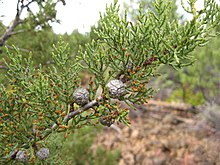Hesperocyparis bakeri
| Hesperocyparis bakeri | |
|---|---|

| |
| Scientific classification | |
| Kingdom: | Plantae |
| Clade: | Tracheophytes |
| Clade: | Gymnospermae |
| Division: | Pinophyta |
| Class: | Pinopsida |
| Order: | Cupressales
|
| Family: | Cupressaceae |
| Genus: | Hesperocyparis |
| Species: | H. bakeri
|
| Binomial name | |
| Hesperocyparis bakeri (
Jeps. ) Bartel | |

| |
| Natural range | |
| Synonyms[3] | |
|
List
| |
Hesperocyparis bakeri, previously known Cupressus bakeri,
Description

The evergreen tree has a conic crown, growing to heights of 9–25 meters (30–82 ft),[6] exceptionally to 39 m (130 ft), and a trunk diameter of up to 50 centimeters (20 inches), exceptionally to 1 m (40 in). The bark is thin, red when young, and gray in maturity.[6]
The foliage grows in sparse, very fragrant, usually pendulous sprays, varying from dull gray-green to glaucous blue-green in color. The
The seed cones are globose to oblong, covered in warty resin glands, 10–25 mm (3⁄8–1 in) long, with 6 or 8 (rarely 4 or 10) scales, green to brown at first, maturing gray or gray-brown about 20–24 months after pollination. The male cones are 3–5 mm long, and release pollen in February–March.[8]
Taxonomy
Hesperocyparis bakeri was given its first scientific description and named Cupressus bakeri in 1909 by the botanist
As of 2024 Hesperocyparis bakeri is listed as the correct classification in Plants of the World Online (POWO), World Flora Online,[9] and the USDA Natural Resources Conservation Service PLANTS database (PLANTS).[10]
Distribution and habitat
The tree grows in limited populations in southwestern Oregon's Josephine and Jackson counties, and slightly more populously in a small section of Northern California within Siskiyou, Modoc, Shasta, Plumas and Tehama counties.[11] It is probably the northernmost cypress.[6]
It is usually found in small, scattered populations, not in large forests, at altitudes of 900–2,000 m (3,000–6,600 ft). This includes locales in the
Ecology
The tree's thin bark makes it susceptible to wildfire, exposure to which is required to release the seeds; these then colonize the scorched earth left behind.[6] Fire suppression policies of the past decades have severely limited reproduction of the species. It is listed as a vulnerable species on the IUCN Red List.[13]
See also
- Flora of the Klamath Mountains
- List of plants on the Modoc National Forest
- Milo Samuel Baker
- Rogue River-Siskiyou National Forest
References
- . Retrieved 12 November 2021.
- ^ NatureServe (2024). "Cupressus bakeri". Arlington, Virginia. Retrieved 27 January 2024.
- ^ a b "Hesperocyparis bakeri (Jeps.) Bartel". Plants of the World Online. Royal Botanic Gardens, Kew. Retrieved 26 January 2024.
- ^ Jepson eFlora (JM2): Hesperocyparis bakeri . accessed 8.28.2015.
- ^ a b CalFlora Database: Hesperocyparis bakeri . accessed 8.28.2015.
- ^ OCLC 1141235469.
- ^ Pinetum Photos, trees
- ^ Pinetum Photos, cones
- ^ "Hesperocyparis bakeri (Jeps.) Bartel". World Flora Online. Retrieved 27 January 2024.
- ^ Hesperocyparis bakeri, USDA Natural Resources Conservation Service PLANTS Profile, 27 January 2024
- ^ United States Department of Agriculture plants profile
- ^ Jepson Manual, University of California
- . Retrieved 12 November 2021. – Listed as Vulnerable (VU B1+2bcd v2.3)
External links
- CalFlora Database: Hesperocyparis bakeri (Baker's cypress)
- Jepson Manual eFlora (JM2) treatment of Hesperocyparis bakeri
- USDA Plants Profile for Hesperocyparis bakeri (Modoc cypress)
- Gymnosperm Database: Cupressus bakeri
- photo of herbarium specimen at Missouri Botanical Garden, collected in 1934 in Siskiyou County, California
- UC Calphotos Photos Gallery: Hesperocyparis bakeri
(Hesperocyparis bakeri).


